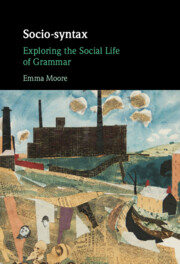Book contents
- Socio-syntax
- Socio-syntax
- Copyright page
- Dedication
- Contents
- Figures
- Tables
- Acknowledgements
- 1 Why Does the Social Meaning of Grammar Matter?
- 2 The Social Landscape of Midlan High
- 3 How Do We Study the Social Meaning of Grammatical Variation?
- 4 How Free Are We to Vary the Grammar We Use?
- 5 How Do We Use Grammar to Design Our Talk?
- 6 Does Everyone Use Grammar to Make Social Meaning?
- 7 How Does Grammar Combine with Other Elements of Language?
- 8 What Does It Mean to View Grammar as a Fluid, Flexible Social Resource?
- References
- Index
6 - Does Everyone Use Grammar to Make Social Meaning?
Published online by Cambridge University Press: 19 October 2023
- Socio-syntax
- Socio-syntax
- Copyright page
- Dedication
- Contents
- Figures
- Tables
- Acknowledgements
- 1 Why Does the Social Meaning of Grammar Matter?
- 2 The Social Landscape of Midlan High
- 3 How Do We Study the Social Meaning of Grammatical Variation?
- 4 How Free Are We to Vary the Grammar We Use?
- 5 How Do We Use Grammar to Design Our Talk?
- 6 Does Everyone Use Grammar to Make Social Meaning?
- 7 How Does Grammar Combine with Other Elements of Language?
- 8 What Does It Mean to View Grammar as a Fluid, Flexible Social Resource?
- References
- Index
Summary
Variants like negative concord may be highly stigmatised because they have obvious standard alternatives in writing. But what about syntactic features that only ever occur in spoken discourse? One example of a variant that meets this criteria is right dislocation: this refers to the occurrence of a clause followed by a noun phrase or pronoun tag which is co-referential with the preceding subject or object pronoun; for instance, ’She’s lovely, her mum’ or ’I’ve not got an accent, me’. The Midlan High data shows that, unlike negative concord, right dislocation is used by all communities of practice, but there are differences in its frequency of use and, particularly, in the precise formulations of right dislocation used by different communities of practice. These differences reflect how speakers make social moves by exploiting the links between precise syntactic configuration and possible meanings. Significantly, this chapter suggests that the frequency with which certain social groups use particular syntactic constructions is a direct consequence of the need or willingness to express the pragmatic meaning the construction encodes.
- Type
- Chapter
- Information
- Socio-syntaxExploring the Social Life of Grammar, pp. 138 - 170Publisher: Cambridge University PressPrint publication year: 2023



